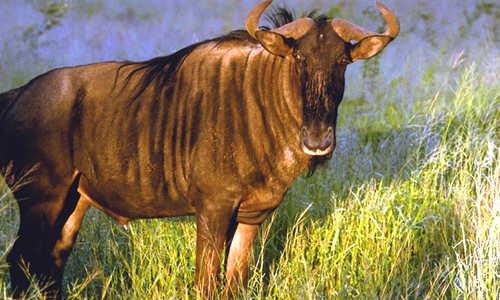What Is The Size Of A Wildebeest
The Wildebeest (genus Connochaetes), as well called a Gnu, is an ungulate mammal establish in Southern Kenya, S Republic of angola to north south Africa.
In that location are 2 species of wildebeest which are the Black Wildebeest (Connochaetes gnou) and the Bluish Wildebeest (Connochaetes taurinus), both are native to Africa.
Wildebeest are antelopes and belong to the bovidae family which besides includes cows, goats and sheep. Wildebeest are ane of the most abundant big mammals in Africa and in that location is thought to be effectually 1.5 million migratory individuals in the Serengeti alone forming the greatest concentration of wild grazing animals on Earth.
Wildebeest Clarification

Wildebeest measure around ane.5 metres (5 feet) at shoulder height and weigh between 118 – 275 kilograms (260 – 600 pounds). They have large heads with a cow-like face up, a shaggy mane and a pointed beard. Their abrupt, curved horns measure up to i metre across. Both male and female have horns. The forepart role of their trunk is heavily built and they have slender hinds quarters and sparse legs. They take a tail which measures 40 – 50 centimetres long.
Wildebeest Habitat
The wildebeests preferred habitats are grasslands and savannas.
Wildebeest Diet
Wildebeest are grazing herbivores that feed upon grass and succulent plants. Massive herds volition migrate for hundreds of kilometres in search of fresh grass which merely grows afterward the seasonal rainfalls.
Wildebeest Behaviour
Wildebeest move around in massive herds, some stay in the same identify while others are nomadic and are in constant search for new food sources. Many accept to make unsafe crossings such as the Kenya Masai Mara. Migrating wildebeest must cross ii broad rivers where Nile Crocodiles look them. When the crocodiles spot a weak wildebeest, they cake its route back to shore and kickoff to shut in on it.
Wildebeest motion around in huge herds probably because there is safety in numbers. The bigger the grouping, the less risk an individual faces of existence picked out by predators. Predators exercise follow the herds around and volition prey up on the immature and the weak.
Herds of wildebeest drop tonnes of dung while on the move around but it is soon cleared up by swarms of Dung Beetles who curl the dung into assurance and bury it before eating it or laying eggs in it. Sometimes herds of over 500 wildebeest volition stampede and run at over fifty miles per hour and although destructive, the stampedes encourage new plant growth and soil renewal.
Wildebeest are near agile in the mornings and late afternoons mainly resting during the heat of the night and as well during the night. Wildebeest are noisy creatures and make vocalizations which include grunting calls, moans and explosive snorts.
Wildebeest Reproduction
Male person wildebeest mature at three – iv years and females at 2 – 3 years. When the males mature, they will set up their territories which they mark with faeces and secretions emitted from their face up and hoofs. They defend information technology from other males and endeavour to mate with females entering their areas.
Mating activity is seasonal and is usually timed so that the bulk of calves are born close to the first of the rainy season when new grass is plentiful. Upwardly to 500,000 calves are born in February and March each year, at the commencement of the rainy season. A single calf is born after a gestation menses of 8 and a half months each year. Unlike other antelopes, the female does not need to give nascency in a secluded location, she will requite birth in the centre of the herd if need be.
Calves can stand and run inside minutes of being born but they must move with their mothers to have any hazard of surviving as they are very vulnerable to lions, cheetahs, wild dogs and hyenas. Calves are suckled by their mothers for 6 months although they are able to eat grass after 10 days. Males leave the herd when they are one yr sometime to form groups of bachelors.
The life span of a wildebeest in the wild is xx years.
Wildebeest Conservation Status
Wildebeests are abundant and although numbers have increased in the Serengeti, numbers take declined in other areas such as south west Botswana due to competition with livestock. The devastation of crops take prompted farmers to impale wildebeests and likewise gear up long fences to prevent the animals from migrating to wetlands when at that place are seasonal droughts. Continuing survival is dependant on conservation efforts.
What Is The Size Of A Wildebeest,
Source: https://animalcorner.org/animals/wildebeest/
Posted by: sandlinbervelp82.blogspot.com


0 Response to "What Is The Size Of A Wildebeest"
Post a Comment